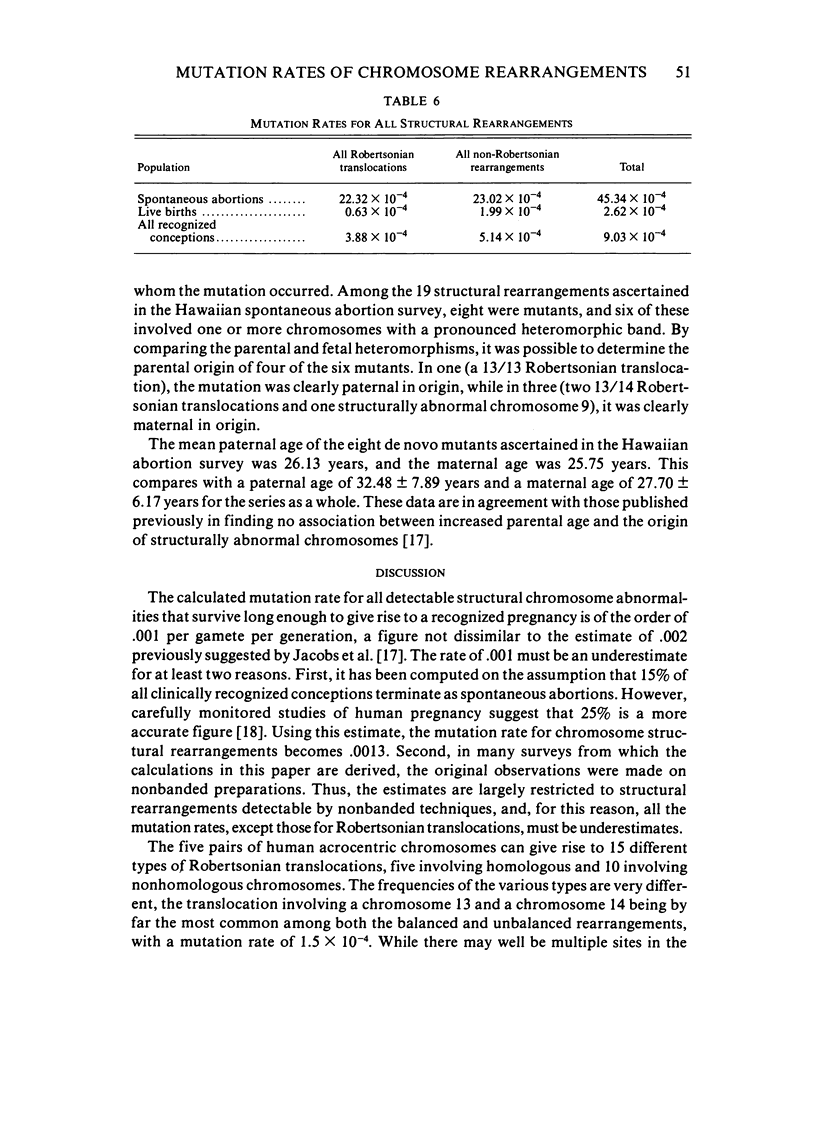Abstract
The gametic mutation rates of human structural chromosome rearrangements have been estimated from rearrangements ascertained from systematic surveys of live births and spontaneous abortions. The mutation rates for rearrangements that survive long enough to give rise to clinically recognized pregnancies are 2.20 X 10(-4) for balanced rearrangements, 3.54 X 10(-4) for unbalanced Robertsonian translocations, and 3.42 X 10(-4) for unbalanced non-Robertsonian rearrangements. These estimates give a mutation rate for all detectable structural chromosome rearrangements of approximately 1 X 10(-3). The most common single rearrangement, the Robertsonian translocation involving chromosomes 13 and 14, has a mutation rate of 1.5 X 10(-4).
Full text
PDF










Selected References
These references are in PubMed. This may not be the complete list of references from this article.
- BIERMAN J. M., SIEGEL E., FRENCH F. E., SIMONIAN K. ANALYSIS OF THE OUTCOME OF ALL PREGNANCIES IN A COMMUNITY.KAUAI PREGNANCY STUDY. Am J Obstet Gynecol. 1965 Jan 1;91:37–45. doi: 10.1016/0002-9378(65)90584-3. [DOI] [PubMed] [Google Scholar]
- Bochkov N. P., Kuleshov N. P., Chebotarev A. N., Alekhin V. I., Midian S. A. Population cytogenetic investigation of newborns in Moscow. Humangenetik. 1974 May 17;22(2):139–152. doi: 10.1007/BF00278453. [DOI] [PubMed] [Google Scholar]
- Boué J., Bou A, Lazar P. Retrospective and prospective epidemiological studies of 1500 karyotyped spontaneous human abortions. Teratology. 1975 Aug;12(1):11–26. doi: 10.1002/tera.1420120103. [DOI] [PubMed] [Google Scholar]
- Creasy M. R., Crolla J. A., Alberman E. D. A cytogenetic study of human spontaneous abortions using banding techniques. Hum Genet. 1976 Feb 29;31(2):177–196. doi: 10.1007/BF00296145. [DOI] [PubMed] [Google Scholar]
- Dutrillaux B., Lejeune J. Etude de la descendance des individus porteurs d'une translocation t(DqDq) Ann Genet. 1970 Mar;13(1):11–18. [PubMed] [Google Scholar]
- Hamerton J. L., Canning N., Ray M., Smith S. A cytogenetic survey of 14,069 newborn infants. I. Incidence of chromosome abnormalities. Clin Genet. 1975 Oct;8(4):223–243. doi: 10.1111/j.1399-0004.1975.tb01498.x. [DOI] [PubMed] [Google Scholar]
- Hassold T. J., Matsuyama A., Newlands I. M., Matsuura J. S., Jacobs P. A., Manuel B., Tsuei J. A cytogenetic study of spontaneous abortions in Hawaii. Ann Hum Genet. 1978 May;41(4):443–454. doi: 10.1111/j.1469-1809.1978.tb00914.x. [DOI] [PubMed] [Google Scholar]
- Jacobs P. A., Frackiewicz A., Law P. Incidence and mutation rates of structural rearrangements of the autosomes in man. Ann Hum Genet. 1972 Mar;35(3):301–319. doi: 10.1111/j.1469-1809.1957.tb01403.x. [DOI] [PubMed] [Google Scholar]
- Jacobs P. A., Melville M., Ratcliffe S., Keay A. J., Syme J. A cytogenetic survey of 11,680 newborn infants. Ann Hum Genet. 1974 May;37(4):359–376. doi: 10.1111/j.1469-1809.1974.tb01843.x. [DOI] [PubMed] [Google Scholar]
- Kajii T., Ferrier A. Cytogenetics of aborters and abortuses. Am J Obstet Gynecol. 1978 May 1;131(1):33–38. doi: 10.1016/0002-9378(78)90470-2. [DOI] [PubMed] [Google Scholar]
- Nielsen J., Sillesen I. Incidence of chromosome aberrations among 11148 newborn children. Humangenetik. 1975 Oct 20;30(1):1–12. doi: 10.1007/BF00273626. [DOI] [PubMed] [Google Scholar]
- Sergovich F., Valentine G. H., Chen A. T., Kinch R. A., Smout M. S. Chromosome aberrations in 2159 consecutive newborn babies. N Engl J Med. 1969 Apr 17;280(16):851–855. doi: 10.1056/NEJM196904172801602. [DOI] [PubMed] [Google Scholar]
- WARBURTON D., FRASER F. C. SPONTANEOUS ABORTION RISKS IN MAN: DATA FROM REPRODUCTIVE HISTORIES COLLECTED IN A MEDICAL GENETICS UNIT. Am J Hum Genet. 1964 Mar;16:1–25. [PMC free article] [PubMed] [Google Scholar]


